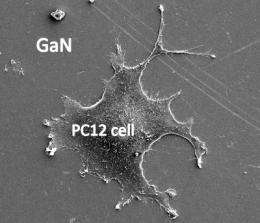Research finds gallium nitride is non-toxic, biocompatible - holds promise for implants

Researchers from North Carolina State University and Purdue University have shown that the semiconductor material gallium nitride (GaN) is non-toxic and is compatible with human cells – opening the door to the material's use in a variety of biomedical implant technologies.
GaN is currently used in a host of technologies, from LED lighting to optic sensors, but it is not in widespread use in biomedical implants. However, the new findings from NC State and Purdue mean that GaN holds promise for an array of implantable technologies – from electrodes used in neurostimulation therapies for Alzheimer's to transistors used to monitor blood chemistry.
"The first finding is that GaN, unlike other semiconductor materials that have been considered for biomedical implants, is not toxic. That minimizes risk to both the environment and to patients," says Dr. Albena Ivanisevic, who co-authored a paper describing the research. Ivanisevic is an associate professor of materials science and engineering at NC State and associate professor of the joint biomedical engineering program at NC State and the University of North Carolina at Chapel Hill.
Researchers used a mass spectrometry technique to see how much gallium is released from GaN when the material is exposed to various environments that mimic conditions in the human body. This is important because gallium oxides are toxic. But the researchers found that GaN is very stable in these environments – releasing such a tiny amount of gallium that it is non-toxic.
The researchers also wanted to determine GaN's potential biocompatibility. To do this they bonded peptides – the building blocks that make up proteins – to the GaN material. Researchers then placed peptide-coated GaN and uncoated GaN into cell cultures to see how the material and the cells interacted.
Researchers found that the peptide-coated GaN bonded more effectively with the cells. Specifically, more cells bonded to the material and those cells spread over a larger area.
"This matters because we want materials that give us some control over cell behavior," Ivanisevic says. "For example, being able to make cells adhere to a material or to avoid it.
"One problem facing many biomedical implants, such as sensors, is that they can become coated with biological material in the body. We've shown that we can coat GaN with peptides that attract and bond with cells. That suggests that we may also be able to coat GaN with peptides that would help prevent cell growth – and keep the implant 'clean.' Our next step will be to explore the use of such 'anti-fouling' peptides with GaN."
More information: "Gallium Nitride is Biocompatible and Non-Toxic Before and After Functionalization with Peptides," forthcoming paper in Acta Biomaterialia.
Provided by North Carolina State University


















